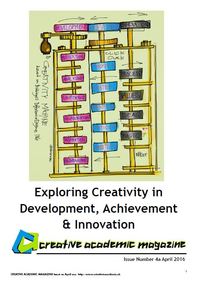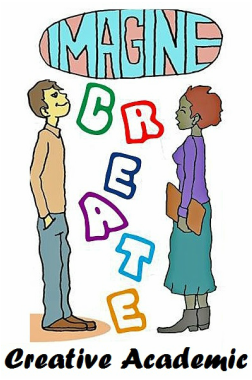
The fourth issue of our magazine is being published during World Creativity and Innovation Week(1) which sets out to encourage people to use their creativity to make the world a better and more interesting place and to make their own lives better and more interesting. WCIW is providing leadership by drawing attention to society's fundamental need for creativity and our fundamental right as a human being to be creative. By its presence WCIW tries to inspire people and organisations to engage in new actions and activities, create novel ideas, make new decisions. It calls on people and organisations who share its values to educate, engage, celebrate and open doors that help people experience freedom from suffering and open new possibilities for them. These values are also values that underlie the work of Creative Academic so we are delighted to be part of this global initiative.
Our contributions include:
1) Establishing a new Creative Academic Google+ Community to encourage sharing of perspectives on creativity
2) Publishing an issue of Creative Academic Magazine on the theme of Creativity in Development, Achievement and Innovation
3) Hosting and facilitating a week-long social learning event Imagineering in Higher Education on the #creativeHE platform.
We are also delighted to have entered a new partnership with Marci Segal, CEO of WCIW to undertake a research study to gain feedback from participants on their contributions.
Our contributions include:
1) Establishing a new Creative Academic Google+ Community to encourage sharing of perspectives on creativity
2) Publishing an issue of Creative Academic Magazine on the theme of Creativity in Development, Achievement and Innovation
3) Hosting and facilitating a week-long social learning event Imagineering in Higher Education on the #creativeHE platform.
We are also delighted to have entered a new partnership with Marci Segal, CEO of WCIW to undertake a research study to gain feedback from participants on their contributions.

Why development is important
While innovation is the buzz word of political and business leaders, development is the unsung hero as it embodies all the effort and ingenuity that connects our ideas with our innovations and achievements - the concrete representations and expressions that give our ideas meaning and practical substance. While Creative Academic might be seen as an organisational innovation it's all the hard work of developing ourselves, our projects and our relationships and resources that sustains our existence and enables us to achieve the things we want to achieve.
Development often gets overlooked as a vehicle for creativity. Our magazine is our vehicle for exploring, developing and sharing ideas and it fits very nicely the developmental concept of creativity proposed by Dellas and Gaier(2) 'creativity is the desire and ability to use imagination, insight, intellect, feeling and emotion to move an idea from one state to an alternative, previously unexplored state'. If we manage to do this successfully then we have achieved something valuable.
But this concept of creativity gives little consideration to the developmental process, activities, interactions, relationships, use of resources and creation of new resources, that enables ideas to be moved from one state to another. Our development process to produce our magazine involves searching for information, finding and developing relationships with people and persuading them to share their ideas, experiences, research and insights and other talents. It's a relational process like for example meeting Simon Rae our illustrator on-line during a twitter conversation and inviting him to create some wonderful cartoons to provide another perspective on the ideas being shared. Gradually through this partly organised but often emergent process we (the editorial team) change our understandings as we develop and personalise the knowledge that is gathered, produced and connected. It's a co-creative process involving all the people who contribute. In this way we make our own distinctive contribution to exploring and developing ideas in our particular context.
Creativity is all about having ideas that are new to us, and sometimes new to others, that interest and excite us to do something. Sometimes these new ideas seem to just come into our awareness but more often they form when we connect and combine ideas that have been around for a while(3). Such hybrid ideas often form when we connect our imaginings to a context, a problem or situation that makes our thoughts useful. The idea Creative Academic is developing, through the slow collision of ideas, is the idea that creativity is integral to our ecology for learning, developing and achieving(4).
A person's creativity only has meaning when it is developed and applied in the context and circumstances of the things they care about in their life (4,5). One of the things we (the editorial team) care about is producing this issue of the magazine so it becomes, for a while, the purpose for our creativity and our enterprise is focused on connecting ideas and finding people who are willing to share their ideas and perspectives.
While innovation is the buzz word of political and business leaders, development is the unsung hero as it embodies all the effort and ingenuity that connects our ideas with our innovations and achievements - the concrete representations and expressions that give our ideas meaning and practical substance. While Creative Academic might be seen as an organisational innovation it's all the hard work of developing ourselves, our projects and our relationships and resources that sustains our existence and enables us to achieve the things we want to achieve.
Development often gets overlooked as a vehicle for creativity. Our magazine is our vehicle for exploring, developing and sharing ideas and it fits very nicely the developmental concept of creativity proposed by Dellas and Gaier(2) 'creativity is the desire and ability to use imagination, insight, intellect, feeling and emotion to move an idea from one state to an alternative, previously unexplored state'. If we manage to do this successfully then we have achieved something valuable.
But this concept of creativity gives little consideration to the developmental process, activities, interactions, relationships, use of resources and creation of new resources, that enables ideas to be moved from one state to another. Our development process to produce our magazine involves searching for information, finding and developing relationships with people and persuading them to share their ideas, experiences, research and insights and other talents. It's a relational process like for example meeting Simon Rae our illustrator on-line during a twitter conversation and inviting him to create some wonderful cartoons to provide another perspective on the ideas being shared. Gradually through this partly organised but often emergent process we (the editorial team) change our understandings as we develop and personalise the knowledge that is gathered, produced and connected. It's a co-creative process involving all the people who contribute. In this way we make our own distinctive contribution to exploring and developing ideas in our particular context.
Creativity is all about having ideas that are new to us, and sometimes new to others, that interest and excite us to do something. Sometimes these new ideas seem to just come into our awareness but more often they form when we connect and combine ideas that have been around for a while(3). Such hybrid ideas often form when we connect our imaginings to a context, a problem or situation that makes our thoughts useful. The idea Creative Academic is developing, through the slow collision of ideas, is the idea that creativity is integral to our ecology for learning, developing and achieving(4).
A person's creativity only has meaning when it is developed and applied in the context and circumstances of the things they care about in their life (4,5). One of the things we (the editorial team) care about is producing this issue of the magazine so it becomes, for a while, the purpose for our creativity and our enterprise is focused on connecting ideas and finding people who are willing to share their ideas and perspectives.

We hope you enjoy reading our contribution to WCIW
Sources and links
1 World Creativity and Innovation Week http://wciw.org/
2 Dellas, M. and Gaier, E.L. (1970) Identification of Creativity in the Individual Psychological Bulletin 73, 55-73
3 Johnson, S. (2010) Where good ideas come from RSA Animate YouTube
https://www.youtube.com/watch?v=NugRZGDbPFU
4 Jackson N J (2016) Exploring Learning Ecologies Chalk Mountain available at: https://www.lulu.com/
5 Rogers, C.R (1961) On becoming a person. Boston: Houghton Mifflin
Sources and links
1 World Creativity and Innovation Week http://wciw.org/
2 Dellas, M. and Gaier, E.L. (1970) Identification of Creativity in the Individual Psychological Bulletin 73, 55-73
3 Johnson, S. (2010) Where good ideas come from RSA Animate YouTube
https://www.youtube.com/watch?v=NugRZGDbPFU
4 Jackson N J (2016) Exploring Learning Ecologies Chalk Mountain available at: https://www.lulu.com/
5 Rogers, C.R (1961) On becoming a person. Boston: Houghton Mifflin

 RSS Feed
RSS Feed
